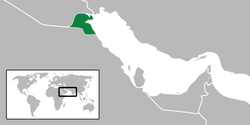|
دولة الكويت | ||||

|

| |||
| Anthem Al-Nasheed Al-Watani | ||||
| ||||
| Capital | Kuwait City | |||
| Government | Constitutional monarchy | |||
| Emir | ||||
| - From 2011 | Sabah Al-Ahmad Al-Jaber Al-Sabah | |||
| Prime Minister | ||||
| - From 2011 | Nasser Al-Mohammad Al-Ahmad Al-Sabah Prime Minister | |||
| Legislature | National Assembly | |||
| History | ||||
| - June 19, 1961 | Established | |||
| Area | 17,820 km² | |||
| Population | ||||
| - 2010 | 3,566,437 | |||
| Density | 200.1/km² | |||
| GDP | 2010 (PPP) | |||
| - Total | US$ 134.9 billion | |||
| - Per capita | US$ 37,848 | |||
| Currency | Kuwaiti dinar | |||
| v | ||||
The State of Kuwait is a constitutional monarchy in Southwest Asia.
Background
Britain oversaw foreign relations and defense for the ruling Kuwaiti AL-SABAH dynasty from 1899 until independence in 1961. Kuwait was attacked and overrun by Iraq on 2 August 1990. Following several weeks of aerial bombardment, a US-led, UN coalition began a ground assault on 23 February 1991 that liberated Kuwait in four days. Kuwait spent more than $5 billion to repair oil infrastructure damaged during 1990-91. The AL-SABAH family has ruled since returning to power in 1991 and reestablished an elected legislature that in recent years has become increasingly assertive. The country witnessed the historic election in May 2009 of four women to its National Assembly. Amid the 2010-11 uprisings and protests across the Arab world, stateless Arabs, known as bidoon, staged small protests in February and March 2011 demanding citizenship, jobs, and other benefits available to Kuwaiti nationals. Youth activist groups - supported by opposition legislators and the prime minister's rivals within the ruling family - in March of 2011 rallied for an end to corruption and the prime minister's ouster.[1]
Economy
Kuwait has a geographically small, but wealthy, relatively open economy with self-reported crude oil reserves of about 102 billion barrels - about 9% of world reserves. Petroleum accounts for nearly half of GDP, 95% of export revenues, and 95% of government income. Kuwaiti officials have committed to increasing oil production to 4 million barrels per day by 2020. The rise in global oil prices throughout 2010 is reviving government consumption and economic growth as Kuwait experiences a 20% increase in government budget revenue. Kuwait has done little to diversify its economy, in part, because of this positive fiscal situation, and, in part, due to the poor business climate and the acrimonious relationship between the National Assembly and the executive branch, which has stymied most movement on economic reforms. Nonetheless, the government in May 2010 passed a privatization bill that allows the government to sell assets to private investors, and in January passed an economic development plan that pledges to spend up to $130 billion in five years to diversify the economy away from oil, attract more investment, and boost private sector participation in the economy. Increasing government expenditures by so large an amount during the planned time frame may be difficult to accomplish.[2]
Emir
- Sabah Al-Ahmad Al-Jaber Al-Sabah (₩) (January 1, 2011 - )
Prime Minister
- Nasser Al-Mohammad Al-Ahmad Al-Sabah Prime Minister (₩) (January 1, 2011 - )
Nation
Kuwaiti Polities
Protectorate of Kuwait
Republic of Kuwait
Province of Kuwait
Neighbouring Nations
References
- Country Studies: Kuwait (Library of Congress)
- The World Factbook (CIA)
- Chiefs of State and Cabinet Members of Foreign Governments (CIA)
- U.S. Department of State
- Australian Government
- Inter-Parliamentary Union - National Assembly
- BBC News Country Profile
- BBC News Time Line
- World Statesmen.org
- Psephos Election Archive
- Wikipedia
